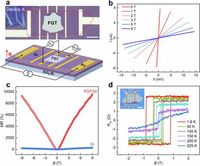In a groundbreaking study, researchers have achieved a remarkable breakthrough in magnetoresistance (MR) technology, reporting a positive MR of up to approximately 9400% at room temperature (RT). This extraordinary level of magnetoresistance was observed by stacking a van der Waals ferromagnet, Fe3GeTe2 (FGT), on top of graphene to create a novel hybrid structure known as FGT/Gr heterostructure. More notably, this giant MR remains stable over a significant temperature range, existing in viable applications from room temperature all the way down to 4 K.
Published in Nature Communications on March 24, 2025, this study has the potential to catalyze advancements in the design of high-sensitivity MR sensors. Current applications of MR technology require devices that can operate effectively under varying thermal conditions without compromising performance. With the identified characteristics of this new material combination, researchers may be able to overcome existing challenges in sensor technology.
The researchers explained that magnetoresistance is a crucial effect that allows the sensing of magnetic fields with very low energy requirements, making it integral for developments in both fundamental science and a wide array of applications. Previous advances in MR materials, including various two-dimensional (2D) structures, showed promising but limited performance, particularly when it came to temperature sensitivity. Many of these materials tended to exhibit the best properties at low temperatures, with significant performance drops as temperature increased.
Unlike these predecessors, the FGT/Gr heterostructure not only displayed outstanding magnetoresistance at RT but also showed resilience in maintaining its performance across a wide range of temperatures. The research team used a straightforward fabrication technique involving a dry transfer method, followed by electron-beam lithography to pattern electrodes on monolayer graphene.
Through comprehensive testing, including longitudinal resistance measurements under applied magnetic fields, the results revealed that the MR reached a remarkable 9400% under a magnetic field of 9 T. In contrast, the pure graphene regions demonstrated much lower MR values—less than 300%. This indicates more than a thirty-fold enhancement when compared to traditional graphene-based systems, setting a new record in the field.
The giant MR effect has strong relevance because it stems from spin-dependent orbital coupling between the FGT and graphene layers. This mechanism breaks the spin degeneracy found in pure graphene, leading to distinct conductivities for different spin channels. As external magnetic fields are applied, the density of the spin minority carriers decreases sharply, causing the conductivity to reduce dramatically. This unique characteristic allows for stable magnetoresistance across various operational conditions.
Researchers conducted additional control experiments to rule out contributions from FGT alone, which typically has negligible MR on its own. They noted that the Curie temperature of FGT is about 210 K, below which it can maintain magnetic properties. This means that FGT alone cannot augment the MR of the heterostructure without its interaction with graphene.
To further understand the nature of the observed giant MR, the authors performed detailed theoretical calculations using density functional theory (DFT). They emphasized that the key to the unique substantial enhancement lies in the magnetic interfacial coupling and the distinctive hybridization effects observed when FGT is combined with graphene.
Moreover, the research highlights the efficacy of vacuum annealing as a strategy for improving MR in the heterostructure. Devices that underwent vacuum annealing at enhanced temperatures exhibited significant MR increases—achieving values above 2000% with the maximum value recorded at approximately 9400%. This demonstrates that the heterostructures can be fine-tuned for optimal performance, promoting the idea of practical application in developing highly sensitive MR sensors.
The implications of this research extend beyond academic curiosity; they indicate a promising pathway for advancing sensor technologies, impacting industries that rely on magnetic sensing and data storage, among others. The findings not only deepen our understanding of fundamental magnetoresistance effects but also pave the way for emerging technologies in spintronic devices.
This work underscores the delicate interplay between material composition and functionality, a critical consideration for researchers and engineers in the ongoing quest to improve electronic devices. As the field continues to evolve, the introduction of new hybrid materials such as the FGT/Gr combination represents a step forward in material science, affecting everything from consumer electronics to sophisticated scientific instruments.
In conclusion, this significant discovery emphasizes the role of novel material combinations in revolutionizing how we design and implement magnetic sensor technologies. With continued research and innovation, the promise of graphene-based magnetic sensors functioning effectively over a wide temperature range is closer to reality than ever before.

